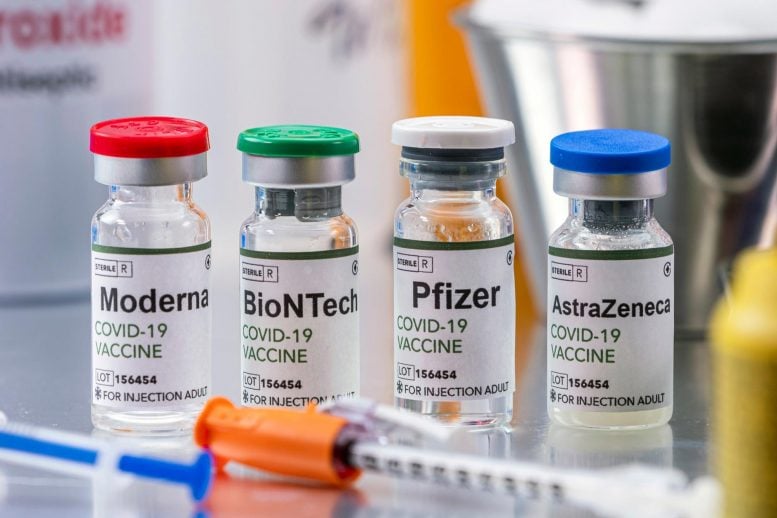
Initial data suggests that mixing Pfizer/Oxford-AstraZeneca vaccine doses leads to more frequent mild to moderate reactions compared to standard dosing schedules.
- Research, from Com-COV study comparing mixed dosing schedules of Pfizer / Oxford-AstraZeneca vaccines, shows increase in the frequency of mild-moderate symptoms in those receiving either mixed dosing schedule
- Adverse reactions were short-lived, with no other safety concerns
- Impact of mixed schedules on immunogenicity unknown as yet, with data to follow from this study
Researchers running the University of Oxford-led Com-COV study — launched earlier this year to investigate alternating doses of the Oxford-AstraZeneca vaccine and the Pfizer vaccine — have today reported preliminary data revealing more frequent mild to moderate reactions in mixed schedules compared to standard schedules.
Writing in a peer-reviewed Research Letter published in the Lancet, they report that, when given at a four-week interval, both of the ‘mixed’ schedules (Pfizer-BioNTech followed by Oxford-AstraZeneca, and Oxford-AstraZeneca followed by Pfizer-BioNTech) induced more frequent reactions following the 2nd, ‘boost’ dose than the standard, ‘non-mixed’ schedules. They add that any adverse reactions were short-lived and there were no other safety concerns.
Matthew Snape, Associate Professor in Paediatrics and Vaccinology at the University of Oxford, and Chief Investigator on the trial, said:
“Whilst this is a secondary part of what we are trying to explore through these studies, it is important that we inform people about these data, especially as these mixed-doses schedules are being considered in several countries. The results from this study suggest that mixed dose schedules could result in an increase in work absences the day after immunization, and this is important to consider when planning immunization of health care workers.
“Importantly, there are no safety concerns or signals, and this does not tell us if the immune response will be affected. We hope to report these data in the coming months. In the meantime, we have adapted the ongoing study to assess whether early and regular use of paracetamol reduces the frequency of these reactions.”
They also noted that as the study data was recorded in participants aged 50 and above, there is a possibility such reactions may be more prevalent in younger age groups.
Reference: “Heterologous prime-boost COVID-19 vaccination: initial reactogenicity data” by Robert H Shaw, Arabella Stuart, Melanie Greenland, Xinxue Liu, Jonathan S Nguyen Van-Tam, Matthew D Snape and theCom-COV Study Group, 12 May 2021, The Lancet.
DOI: 10.1016/S0140-6736(21)01115-6
About the Com-Cov trial:
The study has been classified as an Urgent Public Health study by the NIHR and is being undertaken by NISEC and the Oxford Vaccine Group, with funding of £7 million from the government through the Vaccines Taskforce.
The University of Oxford is leading the study, run by the National Immunisation Schedule Evaluation Consortium (NISEC) and backed by £7 million of government funding from the Vaccines Taskforce.
It aims to evaluate the feasibility of using a different vaccine for the initial ‘prime’ vaccination to the follow-up ‘booster’ vaccination, helping policymakers explore whether this could be a viable route to increase the flexibility of vaccination programs.
The trial recruited 830 volunteers aged 50 and above from eight National Institute for Health Research (NIHR) supported sites in England to evaluate the four different combinations of prime and booster vaccination: a first dose of the Oxford-AstraZeneca vaccine followed by boosting with either the Pfizer vaccine or a further dose of the Oxford-AstraZeneca vaccine, or a first dose of the Pfizer vaccine followed by boosting with either the Oxford-AstraZeneca vaccine or a further dose of the Pfizer vaccine.
In April, the researchers expanded the program to include the Moderna and Novavax vaccines in a new study (Com-Cov2), run across nine National Institute for Health Research supported sites by NISEC and backed through funding from the Vaccines Taskforce and the Coalition for Epidemic Preparedness Innovations. Volunteers would have received either the Oxford-AstraZeneca or Pfizer vaccine, and then randomly allocated to receive either the same vaccine for their second dose or a dose of the COVID-19 vaccines produced by Moderna or Novavax.
The six new ‘arms’ of the trial each aimed to recruit 175 candidates, adding a further 1050 recruits into this program.
Both studies are designed as so-called ‘non-inferiority’ studies — the intent is to demonstrate that mixing is not substantially worse than not mixing — and will compare the immune system responses to the gold-standard responses reported in previous clinical trials of each vaccine.
About the Oxford Vaccine Group
The Oxford Vaccine Group (OVG) conducts studies of new and improved vaccines for children and adults and is based in the Department of Paediatrics at the University of Oxford. The multidisciplinary group includes consultants in vaccinology, a Director of Clinical Trials, a Senior Clinical Trials Manager, adult and pediatric clinical research fellows, adult and pediatric research nurses, project managers, statisticians, QA manager, Clinical Trials IT and Development Lead, and an administration team. The team also includes post-doctoral scientists, research assistants, and DPhil students and we work together with professionals from a range of specialties such as immunologists, microbiologists, epidemiologists, health communicators, and a sociologist, a community pediatrician, the local Health Protection team, and a bioethicist.
OVG is a UKCRC registered clinical trials unit working in collaboration with the Primary Care Trials Unit at the University (registration number: 52).
About the National Institute for Health Research
The National Institute for Health Research (NIHR) is the nation’s largest funder of health and care research. The NIHR was established in 2006 to improve the health and wealth of the nation through research, and is funded by the Department of Health and Social Care. In addition to its national role, the NIHR commissions applied health research to benefit the poorest people in low- and middle-income countries, using Official Development Assistance funding.
About the Vaccines Taskforce
The Vaccines Taskforce (VTF) is a joint unit in the Department for Business, Energy and Industrial Strategy (BEIS) and Department for Health and Social Care (DHSC). The VTF was set up to ensure that the UK population has access to clinically effective and safe vaccines as soon as possible, while working with partners to support international access to successful vaccines.
The Vaccines Taskforce comprises a dedicated team of private sector industry professionals and officials from across government who are working at speed to build a portfolio of promising vaccine candidates that can end the global pandemic.
The UK has secured early access to 517 million doses of eight of the most promising vaccine candidates. This includes agreements with:
- BioNTech/Pfizer for 100 million doses
- Valneva for 100 million doses
- Oxford/AstraZeneca who will work to supply 100 million doses of the vaccine being developed by Oxford University
- GlaxoSmithKline and Sanofi Pasteur to buy 60 million doses
- Novavax for 60 million doses
- Janssen for 30 million doses of their not-for-profit vaccine, alongside funding of their Phase 3 clinical trial
- Moderna for 17 million doses
- CureVac for 50 million doses
The Vaccines Taskforce’s approach to securing access to vaccines is through:
- procuring the rights to a diverse range of promising vaccine candidates to spread risk and optimize chances for success
- providing funding for clinical studies, diagnostic monitoring and regulatory support to rapidly evaluate vaccines for safety and efficacy
- providing funding and support for manufacturing scale-up and fill and finish at risk so that the UK has vaccines produced at scale and ready for administration should any of these prove successful
About the University of Oxford
Oxford University has been placed number 1 in the Times Higher Education World University Rankings for the fifth year running, and at the heart of this success is our ground-breaking research and innovation.
Oxford is world-famous for research excellence and home to some of the most talented people from across the globe. Our work helps the lives of millions, solving real-world problems through a huge network of partnerships and collaborations. The breadth and interdisciplinary nature of our research sparks imaginative and inventive insights and solutions.
Through its research commercialization arm, Oxford University Innovation, Oxford is the highest university patent filer in the UK and is ranked first in the UK for university spinouts, having created more than 200 new companies since 1988. Over a third of these companies have been created in the past three years.









Be the first to comment on "Preliminary Data Suggests Mixing COVID-19 Vaccines Increases Frequency of Adverse Reactions"